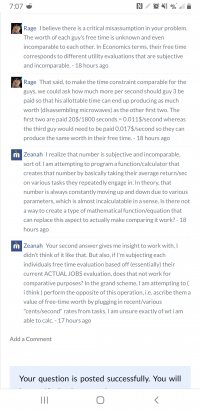Help setting up this word problem please?
The baseline is 21204000s. Every person has this every year. 16 * 365 *60 * 60.
There are four people all making different amounts.And by nature what they do requires a certain amount of into, in time units.
That time is paid in pennies per second to them by an employer.
This leaves each person with a different finite amount of maximum time that they will have that is considered free time or time with which they can choose to do whatever they want to .
18k 8hrs
30k 8hrs
60k 5 hrs
1000k 16*.1 hrs
There is an equation here with which given the right solution the guy making the lowest amount would need to employee his own free time to generate X rate of pennies per second. (In order to match the highest rate, which I am setting at 1m/yr.p
How do I find that rate in pennies per second? I’m trying to program this and it seems like the best way to go about it, bu getting lowest possible metrics.
Not only do I not know how to set this problem up, I feel like there are other operations I could do to derived even more detail/ compare in a different way.
Part 2:
guy #3 Has less time to utilize but gets paid a higher the base rate.
Ex. 18k/yr salary with 8hrs/day FT vs 30k and 5 hr/day FT. Or 30k at 8 hrs FT, and 60k at 5 hrs FT
I feel like this is some kind of function I am trying to derive?
how does this fit into the model and how can I determine if it’s better to have the free time and not get paid the base rate, or have less time but make that base rate…
Which is not a set in stone number, but rather relative.
Like: is 12k more than 18k worth the extra 3 hours/day at whatever rate .
The baseline is 21204000s. Every person has this every year. 16 * 365 *60 * 60.
There are four people all making different amounts.And by nature what they do requires a certain amount of into, in time units.
That time is paid in pennies per second to them by an employer.
This leaves each person with a different finite amount of maximum time that they will have that is considered free time or time with which they can choose to do whatever they want to .
18k 8hrs
30k 8hrs
60k 5 hrs
1000k 16*.1 hrs
There is an equation here with which given the right solution the guy making the lowest amount would need to employee his own free time to generate X rate of pennies per second. (In order to match the highest rate, which I am setting at 1m/yr.p
How do I find that rate in pennies per second? I’m trying to program this and it seems like the best way to go about it, bu getting lowest possible metrics.
Not only do I not know how to set this problem up, I feel like there are other operations I could do to derived even more detail/ compare in a different way.
Part 2:
guy #3 Has less time to utilize but gets paid a higher the base rate.
Ex. 18k/yr salary with 8hrs/day FT vs 30k and 5 hr/day FT. Or 30k at 8 hrs FT, and 60k at 5 hrs FT
I feel like this is some kind of function I am trying to derive?
how does this fit into the model and how can I determine if it’s better to have the free time and not get paid the base rate, or have less time but make that base rate…
Which is not a set in stone number, but rather relative.
Like: is 12k more than 18k worth the extra 3 hours/day at whatever rate .

